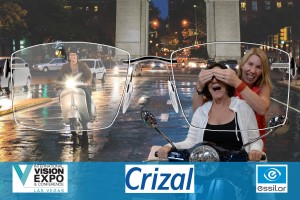It wasn’t all fun and games in Las Vegas this past weekend. Before Peg and I rode the Vespa under the Arc de Triomphe, we checked out the newest progressive lenses and learned some new measurement techniques.
Between Peg and I we attended 12 hours of education ranging from frame manufacturing to oral medications to nutrition. Here are the highlights of each course we want to share with you:
- Global Frame Manufacturing. Italy was once the primary country for eyeglass frame manufacturing, but as with other industries, the factories have relocated in China for economic reasons. The next trend is a shift to India. It takes time to train the workers and get the factories up to standard. The speaker emphasized that the quality of the product isn’t dependent of the country of production, but the individual factory of production. Some frame companies demand the highest standards of skill, environmental impact and human treatment.
- Corneal Cross-Linking. Corneal X-linking is a treatment to stabilize a diseased corneal. Keratoconus is the primary condition that benefits from this procedure, and the earlier in the disease process it is performed the better the outcome and quality of life for the patient. Unfortunately, the US is the only non-third world country that doesn’t have approval. The FDA has delayed approval because corneal X-linking requires Riboflavin, a drug, and UVA radiation, a device. Apparently the FDA drug department and the FDA device department can’t work together. Until it is approved there are test sites in the US or patients have to leave the country for treatment.
- Shades of Grey. Peg went to this course aimed at women and their maturing eyes and the tissue around the eye. Topics such as the risks and benefits of permanent make-up, Botox and Fillers were discussed. Common conditions like dry eye, the causes and treatments were highlighted.
- Eyefoods. This course was presented by Laurie Capogna, O.D., one of the authors of the book Eyefoods that I reviewed. She talked about preventative eyecare through nutrition and lifestyle. 2 take home points are Eyefoods do not Replace Supplements and Supplements do not Replace Eyefoods.
- Strong and Unusual Lenses. The gist of this lecture was predicting the thickness and weight of lenses in various prescriptions. Utilizing different materials and lens treatments can improve the appearance and clarity of a high powered lens.
- Oral Medications. This class included antibiotics, antivirals, steroids and supplements. The ocular complications of systemic medications was also covered. For example Prozac can cause dry eye, light sensitivity and red eyes. Tamoxifen can cause changes to the macula.
- Trouble-Shooting Eyewear Problems. The most important point in this class was to start with a good fitting frame. Not all frame designs work with all prescriptions and not all styles fit all faces.
Besides classes, we spent a lot of time in the exhibition hall which was divided into 3 areas: Eyewear & Accessories, Lenses & Processing Technology and Medical and Scientific. I purchased a new piece of testing equipment that I will talk more about when it arrives. We also visited vendors of dry eye treatments whose products Dr. Staton and I will be evaluating so we can better address our patient’s dry eye issues. Lastly, Peg visited many frame companies. She has a short list of new products that we will transition into our dispensary as we update our frames.
